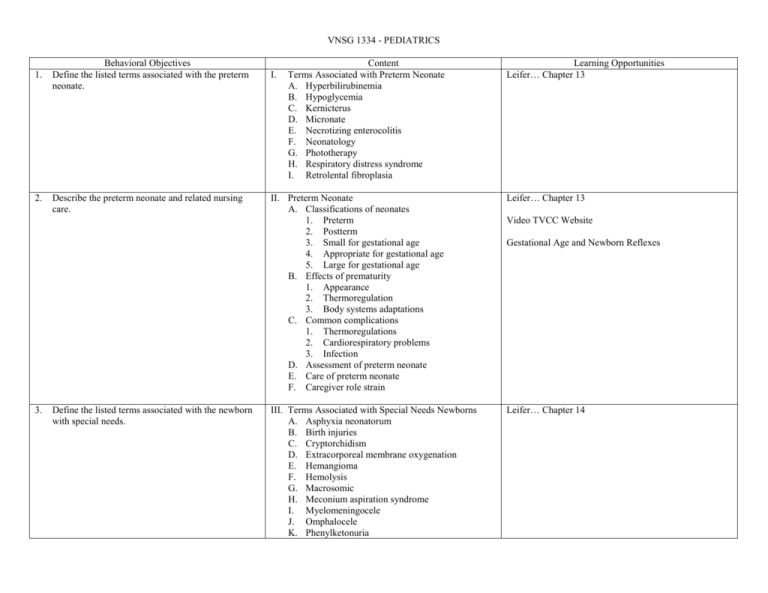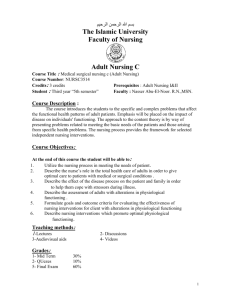VNSG 1334 Pediatric Objectives
advertisement

VNSG 1334 - PEDIATRICS 1. 2. 3. Behavioral Objectives Define the listed terms associated with the preterm neonate. Describe the preterm neonate and related nursing care. Define the listed terms associated with the newborn with special needs. I. Content Terms Associated with Preterm Neonate A. Hyperbilirubinemia B. Hypoglycemia C. Kernicterus D. Micronate E. Necrotizing enterocolitis F. Neonatology G. Phototherapy H. Respiratory distress syndrome I. Retrolental fibroplasia Learning Opportunities Leifer… Chapter 13 II. Preterm Neonate A. Classifications of neonates 1. Preterm 2. Postterm 3. Small for gestational age 4. Appropriate for gestational age 5. Large for gestational age B. Effects of prematurity 1. Appearance 2. Thermoregulation 3. Body systems adaptations C. Common complications 1. Thermoregulations 2. Cardiorespiratory problems 3. Infection D. Assessment of preterm neonate E. Care of preterm neonate F. Caregiver role strain Leifer… Chapter 13 III. Terms Associated with Special Needs Newborns A. Asphyxia neonatorum B. Birth injuries C. Cryptorchidism D. Extracorporeal membrane oxygenation E. Hemangioma F. Hemolysis G. Macrosomic H. Meconium aspiration syndrome I. Myelomeningocele J. Omphalocele K. Phenylketonuria Leifer… Chapter 14 Video TVCC Website Gestational Age and Newborn Reflexes VNSG 1334 - PEDIATRICS Behavioral Objectives Content L. Pigmented nevus M. Transient tachypnea of the newborn Learning Opportunities 4. Discuss the nursing care for the newborn with special needs. IV. Special needs situations A. Respiratory dysfunction B. Congenital problems C. Chromosomal abnormalities D. Inborn errors of metabolism E. Hemolytic diseases of the newborn F. Infections G. Newborn of diabetic mother H. Newborn of substance-abusing mother Leifer… Chapter 14 5. Discuss adaptations of nursing care for pediatric patients. V. Pediatric Nursing Adaptations A. Changes in pediatric nursing practice B. Family, cultural, and religious care of children C. Care of pediatric clients by age group: 1. Infants 2. Toddlers 3. Preschool 4. School-age 5. Adolescent D. General pediatric nursing care issues 1. Admission 2. Operative care 3. Ambulatory care 4. Safety 5. Specimen collection 6. Medication administration E. Special pediatric nursing care issues 1. Dying child 2. Chronic illness 3. Pain management 4. Health promotion a. Immunizations b. Health screenings c. Sex education d. Drug awareness e. Dental care f. Nutrition 5. Community resources Leifer… Chapters 15-22, 26 Students Review on own Leifer… Chapters 16-20 Video TVCC Website Age Specific Competencies Neonates and Infants Toddlers through Teens Adults Video TVCC Website Assessing Pediatric Pain Treating Pediatric Pain Understanding Pediatric Pain VNSG 1334 - PEDIATRICS 6. 7. Behavioral Objectives Define the terms listed related to pediatric respiratory and cardiac disorders. Content VI. Terms Associated with Pediatric Respiratory and Cardiac Disorders A. Acyanotic B. Anatomic variations C. Apnea D. Physiologic variations E. Atelectasis F. Bronchitis G. Bronchopulmonary dysplasia H. Bronciolitis I. Bruit J. Carotid sinus K. Clubbing L. Fremitus M. Murmur N. Pneumonia O. Precordium P. Pulmonary function tests Q. Referred sounds R. Retraction S. Rhinitis T. Sensitivity U. Thrill Describe the etiology, symptomatology, diagnosis, medical treatment, and nursing management (using the nursing process) of pediatric respiratory disorders. VII. Respiratory System Disorders A. Diagnostic tests 1. Cultures 2. Blood tests 3. Pulmonary functions 4. Pulse oximetry 5. Thermistor oxygenation pneumocardiograms 6. X-rays B. Common respiratory disorders 1. Pharyngitis/laryngitis 2. Tonsillitis/adenoiditis 3. Croup 4. Respiratory syncytial virus 5. Asthma/reactive airway disease 6. Cystic fibrosis 7. Sudden infant death syndrome 8. Epistaxis Learning Opportunities Leifer… Chapter 25 Review Infant/Child CPR VNSG 1334 - PEDIATRICS Behavioral Objectives 8. Describe the etiology, symptomatology, diagnosis, medical treatment, and nursing management (using the nursing process) of pediatric cardiac disorders. 9. Define the terms listed associated with hematological disorders. 10. Describe the etiology, symptomatology, diagnosis, medical treatment, and nursing management (using the nursing process) of pediatric hematological disorders. Content 9. Foreign bodies C. Nursing care for respiratory disorders VIII. Cardiac System Disorders A. Diagnostic tests 1. Electrocardiagrams 2. Cardiac catheterizations B. Common cardiac disorders 1. Congenital heart defects 2. Congestive heart failure 3. Rheumatic fever/heart disease C. Nursing care for cardiac disorders IX. Terms Associated with Hematological Disorders A. Blood dyscrasias B. Coagulation C. Hodgkin’s disease D. Jaundice E. Malignancy F. Metastasis G. Neuroblastoma H. Occult blood I. Plasma J. Rhabdosarcoma K. Thrombus L. Viscosity X. Hematological System Disorders A. Diagnostic tests 1. Blood tests 2. Specimens for occult blood 3. Bone marrow aspiration 4. Computed tomography scan 5. Magnetic resonance imaging 6. Lumbar puncture B. Common hematological disorders 1. Anemias 2. Sickle cell anemia 3. Hemophilia 4. Leukemia C. Nursing care for hematological disorders Learning Opportunities VNSG 1334 - PEDIATRICS Behavioral Objectives 11. Define the listed terms associated with musculoskeletal disorders. Content XI. Terms Associated with Musculoskeletal Disorders A. Crepitus B. Fasciculations C. Fractures D. Ortolani's maneuver E. Osteomyelitis F. Rickets G. Sedimentation rate (sed rate) H. Spica cast I. Sprain J. Strain K. Tendons 12. Using the nursing process, explain the nursing management for musculoskeletal disorders. XII. Musculoskeletal Disorders A. Diagnostic tests 1. Blood tests 2. X-ray studies 3. Bone scan 4. Muscle biopsy B. Common musculoskeletal disorders 1. Duchenne's muscular dystrophy 2. Trauma 3. Juvenile rheumatoid arthritis 4. Scoliosis 5. Club foot 6. Dislocated hip 7. Ewing’s sarcoma (Osteosarcoma) C. Nursing care for musculoskeletal disorders 1. Care of patients with casts and traction a. Assessment of the 5 Ps 13. Define the listed terms associated with neurological disorders. XIII. Terms Associated with Neurological Disorders A. Amblyopia B. Anesthesia C. Brain death D. Coma E. Congenital cataract F. Conjunctivitis G. Corneal abrasion H. Dermatome I. Developmental delay J. Extensor posturing Learning Opportunities Leifer… Chapter 24 Video #54 & 55 “Care of a Patient in a Cast (Part I & II) Leifer… Chapter 23 VNSG 1334 - PEDIATRICS Behavioral Objectives K. L. M. N. O. P. Q. R. S. T. U. V. W. X. 14. Describe the etiology, symptomatology, diagnosis, medical treatment, and nursing management (using the nursing process) of pediatric neurological, eye and ear disorders. Content Febrile seizure Flexure posturing Gliomas Insomnia Myringotomy Night terrors Nightmares Obtunded Perception Retrolental fibroplasia Sleep deprivation Spinal cord injury Strabismus Stuporous XIV. Neurological/Eye/Ear disorders A. Diagnostic tests 1. Brain scan 2. Electroencephalogram (EEG) B. Common Neurological disorders 1. Neural tube defects a. Hydrocephaly b. Spina bifida 1.) Occulta 2.) Meningocele 3.) Myelomeningocele 2. Cerebral palsy 3. Mental retardation 4. Down's syndrome 5. Head injuries 6. Increased ICP 7. Seizures a. Generalized b. Partial c. Febrile 8. Eye infections 9. Eye injuries 10. Strabismus 11. Otitis media C. Nursing care for neurological/eye/ear disorders Learning Opportunities VNSG 1334 - PEDIATRICS Behavioral Objectives 15. Define the listed terms associated with integumentary disorders. Content XV. Terms Associated with Integumentary Disorders A. Alopecia B. Autoinoculation C. Blanch D. Burns E. Candidiasis F. Cellulitis G. Contractures H. Cryosurgery I. Dermatitis J. Donor site K. Erythema infectiosum (Fifth’s Disease) L. Eschar M. Furuncles N. Graft O. Infestation P. Keratinization Q. Molluscum contagiosum R. Nevi S. Psoriasis T. Scabies U. Scarlet fever V. Verruca Learning Opportunities Leifer… Chapter 29 16. Describe the etiology, symptomatology, diagnosis, medical treatment, and nursing management (using the nursing process) of pediatric integumentary disorders. XVI. Integumentary disorders A. Diagnostic tests 1. Wood's light 2. Skin scrapings 3. Potassium hydroxide slides 4. Cultures 5. Blood work B. Common integumentary disorders 1. Tinea 2. Impetigo 3. Pediculi 4. Eczema 5. Acne vulgaris 6. Other-definition only a. Candidiasis b. Scarlet fever c. Cellulitis d. Verruca Leifer… Chapter 29 VNSG 1334 - PEDIATRICS Behavioral Objectives Content e. Molluscum contagiosum f. Erythema infectiosum (Fifth's Disease) g. Scabies h. Dermatitis i. Psoriasis j. Burns C. Nursing care for integumentary disorders Learning Opportunities 17. Define the listed terms associated with gastrointestinal disorders. XVII. Terms Associated with Gastrointestinal Disorders A. Biliary atresia B. Celiac disease C. Chalasia D. Cyclic vomiting syndrome E. Dental injuries F. Encopresis G. Failure to thrive H. Gastroesophageal reflux I. Gluten J. Hirschsprung’s disease K. Imperforate anus L. Intussusception M. Megacolon N. Reflux Leifer… Chapters 27 & 30 (Metabolic) 18. Describe the etiology, symptomatology, diagnosis, medical treatment, and nursing management (using the nursing process) of pediatric gastrointestinal disorders. XVIII. Gastrointestinal disorders A. Diagnostic tests 1. Specimen test for occult blood 2. Blood tests 3. Stool cultures 4. X-ray studies 5. Ultrasound 6. Endoscopy 7. Liver biopsy B. Common gastrointestinal disorders 1. Cleft lip/palate 2. Ingestion of foreign bodies 3. Poisoning 4. Pyloric stenosis 5. Appendicitis 6. Peritonitis 7. Gastroenteritis 8. Irritable bowel syndrome Leifer… Chapter 27, 30 VNSG 1334 - PEDIATRICS Behavioral Objectives Content 9. Chronic inflammatory bowel syndrome 10. Parasites 11. Phenylketonuria C. Nursing care for gastrointestinal disorders 19. Define the listed terms associated with genitourinary disorders. XIX. Terms Associated with Genitourinary Disorders A. Ambiguous genitalia B. Bedwetting/enuresis C. Biofeedback D. Dysfunctional voiding E. Kidney and bladder stones F. Nephrostomy G. Ovarian cyst H. Stasis I. Suprapubic catheter J. Testicular cancer K. Testicular torsion L. Urinary reflux M. Vaginitis 20. Describe the etiology, symptomatology, diagnosis, medical treatment, and nursing management (using the nursing process) of pediatric genitourinary disorders. XX. Genitourinary disorders A. Diagnostic testing 1. Testing with reagent strips 2. Urinalysis 3. Urine culture 4. Renal ultrasound 5. Cystoscopy 6. Voiding cystourethrogram 7. Renal scan 8. Intravenous pyelogram 9. Urodynamics testing 10. Renal needle biopsy B. Common genitourinary disorders 1. Wilm's tumor 2. Hypospadias/epispadias 3. Hydrocele 4. Hernia 5. Cryptorchidism C. Nursing care for genitourinary disorders Learning Opportunities Leifer… Chapter 28 VNSG 1334 - PEDIATRICS Behavioral Objectives 21. Define the listed terms associated with psychosocial disorders. Content XXI. Terms Associated with Psychosocial Disorders A. Anorexia B. Body image C. Bulimia D. Child abuse E. Depression F. Obesity G. Primary prevention H. Role ambiguity I. Role incompetence J. Role overload K. Secondary prevention L. Substance abuse M. Suicide N. Tertiary prevention 22. Describe the etiology, symptomatology, diagnosis, medical treatment, and nursing management (using the nursing process) of pediatric psychosocial disorders. XXII. Psychosocial Disorders A. Self-concept B. Stress and coping responses C. Roles and relationships D. Health perception and health maintenance E. Values and beliefs F. The dying child G. Common psychosocial disorders 1. Attention deficit hyperactivity disorder 2. Learning disorders 3. Autism H. Nursing care for psychiatric disorders Video 23. Define the listed terms associated with communicable diseases in children. XXIII. A. B. C. D. E. F. G. H. I. J. K. L. Leifer… Chapter 31 Terms Associated with Communicable Diseases Bulla Crust Cyst Ecchymosis Macule Mononucleosis Opisthotonos Papule Petechiae Pruritis Purpura Pustule Learning Opportunities Physical Abuse (Part 1) Neglect and Emotional Abuse (Part 2) Sexual Abuse (Part 3) VNSG 1334 - PEDIATRICS Behavioral Objectives 24. Describe the etiology, symptomatology, diagnosis, medical treatment, and nursing management (using the nursing process) related to pediatric communicable diseases. v:\word\syllabus\vocation\level ii\vn 1334 pediatrics Content M. Reye’s Syndrome N. Scale O. Vesicle P. Wheal Learning Opportunities XXIV. Communicable Diseases A. Diagnostic Tests 1. Mono spot 2. Titers B. Diseases 1. Rubella 2. Rubeola 3. Varicella 4. Pertussis 5. Strep 6. Parotitis 7. Haemophilus Influenzae Type B (HIB) 8. Tetanus 9. Rabies 3/2013







